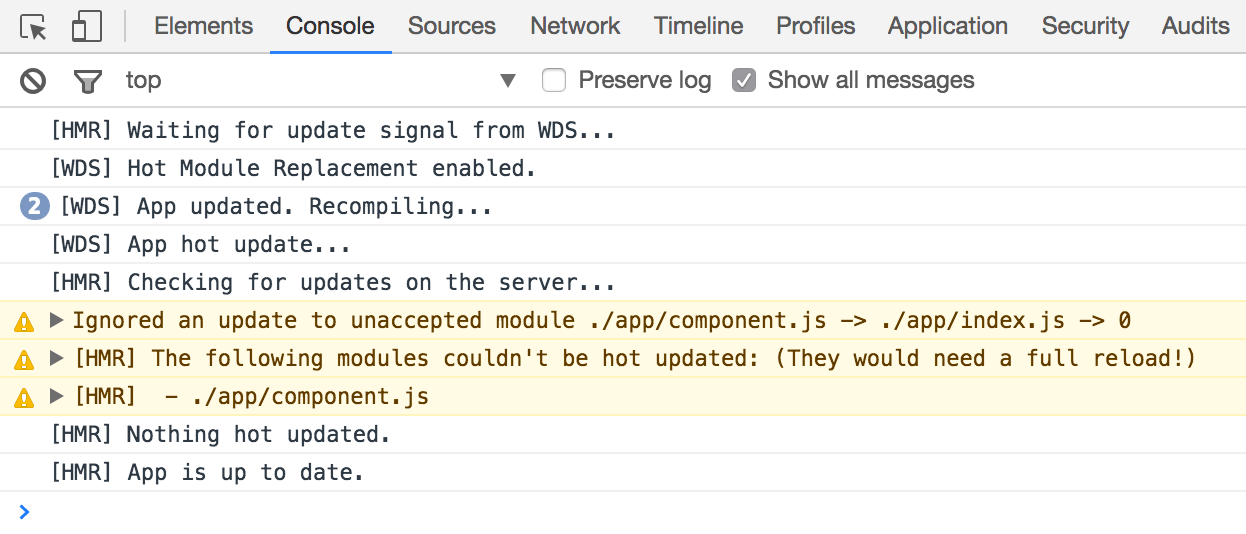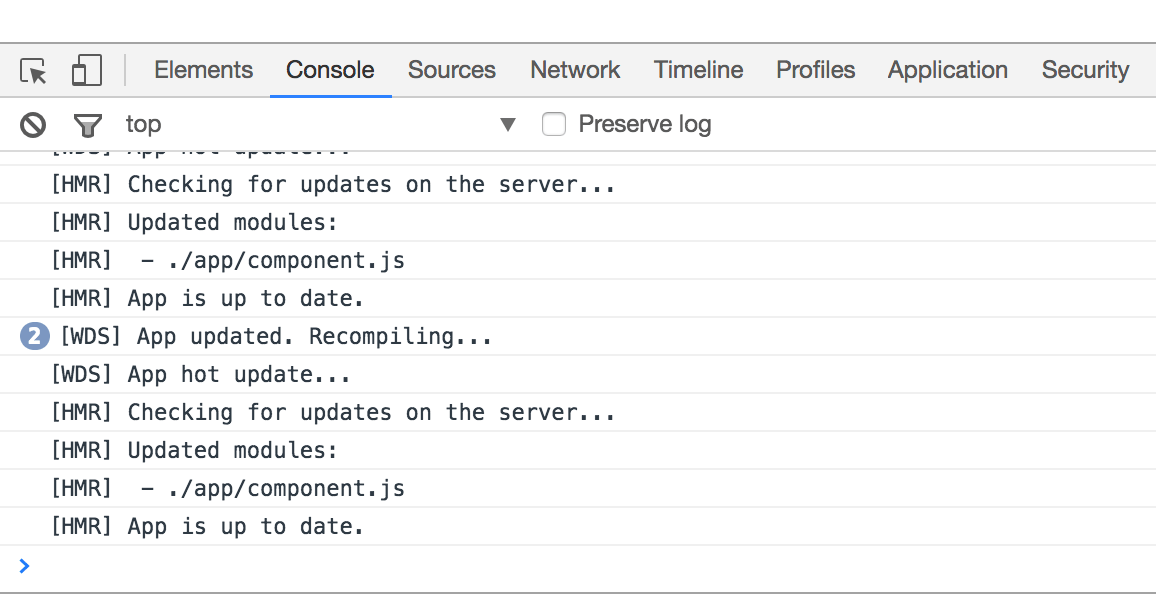Hot Module Replacement
DanielBrachlow (Public Domain)Table of Contents
- Foreword
- Preface
- Introduction
- What is Webpack
- Developing
- Getting Started
- Development Server
- Composing Configuration
- Styling
- Loading Styles
- Separating CSS
- Eliminating Unused CSS
- Autoprefixing
- Loading Assets
- Loader Definitions
- Loading Images
- Loading Fonts
- Loading JavaScript
- Building
- Source Maps
- Code Splitting
- Bundle Splitting
- Tidying Up
- Optimizing
- Minifying
- Tree Shaking
- Environment Variables
- Adding Hashes to Filenames
- Separating a Runtime
- Build Analysis
- Performance
- Output
- Build Targets
- Multiple Pages
- Server-Side Rendering
- Module Federation
- Techniques
- Dynamic Loading
- Web Workers
- Internationalization
- Testing
- Deploying Applications
- Consuming Packages
- Extending
- Extending with Loaders
- Extending with Plugins
- Conclusion
- Appendices
- Comparison of Build Tools
- Hot Module Replacement
- CSS Modules
- Searching with React
- Troubleshooting
- Glossary
Hot Module Replacement (HMR) builds on top of the WDS. It enables an interface that makes it possible to swap modules live. For example, style-loader can update your CSS without forcing a refresh. Implementing HMR for styles is ideal because CSS is stateless by design.
HMR is possible with JavaScript too, but due to application state, it's harder. react-refresh-webpack-plugin and vue-hot-reload-api are good examples.
Given HMR can be complex to implement, a good compromise is to store application state to `localStorage` and then hydrate the application based on that after a refresh. Doing this pushes the problem to the application side.
Enabling HMR#
The following steps need to be enabled for HMR to work:
- The development server has to run in the hot mode to expose the hot module replacement interface to the client.
- Webpack has to provide hot updates to the server and can be achieved using
webpack.HotModuleReplacementPlugin. - The client has to run specific scripts provided by the development server. They will be injected automatically but can be enabled explicitly through entry configuration.
- The client has to implement the HMR interface through
module.hot.acceptand optionallymodule.hot.disposeto clean module before replacing it.
Using webpack-dev-server --hot or running webpack-plugin-serve in hot mode solves the first two problems. In this case, you have to handle only the last one yourself if you want to patch JavaScript application code. Skipping the --hot flag and going through webpack configuration gives more flexibility.
The following listing contains the essential parts related to this approach. You will have to adapt from here to match your configuration style:
{
devServer: {
// Don't refresh if hot loading fails. Good while
// implementing the client interface.
hotOnly: true,
// If you want to refresh on errors too, set
// hot: true,
},
plugins: [
// Enable the plugin to let webpack communicate changes
// to WDS. --hot sets this automatically!
new webpack.HotModuleReplacementPlugin(),
],
}
Starting from webpack 5, there's an alternative to `module.hot`. `import.meta.webpackHot` has been designed with ES2015 modules and Node mjs file extension in mind as it doesn't allow mixing CommonJS and ES2015 syntax.
If you implement configuration like above without implementing the client interface, you will most likely end up with an error:

The message tells that even though the HMR interface notified the client portion of the code of a hot update, nothing was done about it and this is something to fix next.
The setup assumes you have set `optimization.moduleIds = 'named'`. If you run webpack in `development` mode, it will be on by default.
You should **not** enable HMR for your production configuration. It likely works, but it makes your bundles bigger than they should be.
If you are using Babel, configure it so that it lets webpack control module generation as otherwise, HMR logic won't work! See the _Loading JavaScript_ chapter for the exact setup.
Implementing the HMR interface#
Webpack exposes the HMR interface through a global variable: module.hot. It provides updates through module.hot.accept(<path to watch>, <handler>) function and you need to patch the application there.
The following implementation illustrates the idea against the tutorial application:
src/index.js
import component from "./component";
let demoComponent = component();
document.body.appendChild(demoComponent);
// HMR interface
if (module.hot) {
// Capture hot update
module.hot.accept("./component", () => {
const nextComponent = component();
// Replace old content with the hot loaded one
document.body.replaceChild(nextComponent, demoComponent);
demoComponent = nextComponent;
});
}
If you refresh the browser, try to modify src/component.js after this change, and alter the text to something else, you should notice that the browser does not refresh at all. Instead, it should replace the DOM node while retaining the rest of the application as is.
`module.hot.accept` works with an array of filenames as well. The handler (second parameter) is optional.
The image below shows possible output:

The idea is the same with styling, React, Redux, and other technologies. Sometimes you don't have to implement the interface yourself even as available tooling takes care of that for you.
To prove that HMR retains application state, set up [a checkbox](https://developer.mozilla.org/en-US/docs/Web/HTML/Element/input/checkbox) based component next to the original. The `module.hot.accept` code has to evolve to capture changes to it as well.
The `if(module.hot)` block is eliminated entirely from the production build as minifier picks it up. The _Minifying_ chapter delves deeper into this topic.
[hot-accept-webpack-plugin](https://www.npmjs.com/package/hot-accept-webpack-plugin) and [module-hot-accept-loader](https://www.npmjs.com/package/module-hot-accept-loader) allow you to write `if (module.hot) { module.hot.accept(); }` for each module that was matched. It's useful in case you have modules that should accept hot loading without implementing the patching behavior.
[Deep dive into Hot Module Replacement by Stanimira Vlaeva](https://nativescript.org/blog/deep-dive-into-hot-module-replacement-with-webpack-part-two-handling-updates/) discusses the topic in greater detail.
Setting WDS entry points manually#
In the setup above, the WDS-related entries were injected automatically. Assuming you are using WDS through Node, you would have to set them yourself as the Node API doesn't support injecting. The example below illustrates how to achieve this:
entry: {
hmr: [
// Include the client code. Note host/post.
"webpack-dev-server/client?http://localhost:8080",
// Hot reload only when compiled successfully
"webpack/hot/only-dev-server",
// Alternative with refresh on failure
// "webpack/hot/dev-server",
],
...
},
HMR and dynamic loading#
Dynamic Loading through require.context and HMR requires extra effort:
const req = require.context("./pages", true, /^(.*\.(jsx$))[^.]*$/g);
module.hot.accept(req.id, ...); // Replace modules here as above
Conclusion#
HMR is one of those aspects of webpack that makes it attractive for developers and webpack has taken its implementation far. To work, HMR requires both client and server-side support. For this purpose, webpack-dev-server provides both. You will have to take care with the client-side, though, and either find a solution that implements the HMR interface or implement it yourself.
This book is available through Leanpub (digital), Amazon (paperback), and Kindle (digital). By purchasing the book you support the development of further content. A part of profit (~30%) goes to Tobias Koppers, the author of webpack.